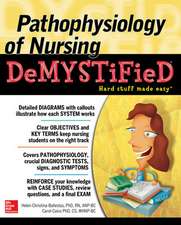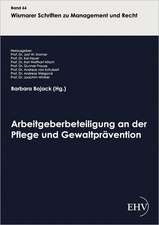Image Interpretation: Bones, Joints, and Fractures
Autor James Harcus, Voyin Panticen Limba Engleză Paperback – 14 aug 2023
A companion to the eighth edition of Bones and Joints, this book covers the basic principles for interpreting images and then follows a simple regional approach to common radiographic projections. It goes on to consider common and important fracture patterns and other injuries related to that region, as well as the differences between normal and abnormal images.
Image Interpretation is an ideal learning guide for undergraduates, those transitioning to graduate roles or clinical practice, and other healthcare professionals wanting to supplement their training.
Preț: 240.91 lei
Preț vechi: 327.99 lei
-27% Nou
Puncte Express: 361
Preț estimativ în valută:
46.10€ • 48.27$ • 38.24£
46.10€ • 48.27$ • 38.24£
Carte disponibilă
Livrare economică 12-26 martie
Livrare express 05-11 martie pentru 114.81 lei
Preluare comenzi: 021 569.72.76
Specificații
ISBN-13: 9780323870801
ISBN-10: 0323870805
Pagini: 336
Ilustrații: 307 illustrations (307 in full color)
Dimensiuni: 191 x 235 x 18 mm
Greutate: 0.7 kg
Editura: Elsevier
ISBN-10: 0323870805
Pagini: 336
Ilustrații: 307 illustrations (307 in full color)
Dimensiuni: 191 x 235 x 18 mm
Greutate: 0.7 kg
Editura: Elsevier
Cuprins
?1- Principles of Image Interpretation
Theory of image viewing (e.g. forming and interpreting patterns); principles of image interpretation when viewing radiographic images (e.g. satisfaction of search, systematic approaches/patterns); types and formats of image interpretation (e.g. preliminary clinical evaluation/comment, clinical reporting); structuring a comment
2- Normal appearances of bones and joints
Normal appearances of bones and joint; normal variants (including differentiating between normal variant and fracture).
3- Fractures and Joint Trauma
Biomechanics of trauma; patterns of injury; fracture types and healing; treatment
Chapters 4-9 will all follow a similar format by addressing each bone/joint in turn by considering:
4- Upper limb
Humerus, forearm, hand; elbow and wrist joints
5- Shoulder girdle and thorax
Clavicle, scapula, sternum, and ribs; shoulder, acromioclavicular, and sternoclavicular joints
6- Lower limb
Femur, tibia and fibula, foot; knee, ankle and foot joints
7- Pelvic girdle
Hip bones; hip joint
8- Spine
Cervical, thoracic, lumbar vertebrae; sacro-iliac joints
9- Facial bones and mandible
10- Practical applications of image interpretation
CPD and audit of image interpretation practices. Role of artificial intelligence.
Theory of image viewing (e.g. forming and interpreting patterns); principles of image interpretation when viewing radiographic images (e.g. satisfaction of search, systematic approaches/patterns); types and formats of image interpretation (e.g. preliminary clinical evaluation/comment, clinical reporting); structuring a comment
2- Normal appearances of bones and joints
Normal appearances of bones and joint; normal variants (including differentiating between normal variant and fracture).
3- Fractures and Joint Trauma
Biomechanics of trauma; patterns of injury; fracture types and healing; treatment
Chapters 4-9 will all follow a similar format by addressing each bone/joint in turn by considering:
- Systematic review of each bone/joint: how to assess, normal appearances/ measurements
- Common normal variants
- Patterns of injury
- Common injuries; radiographic appearances supported by other modalities where appropriate
4- Upper limb
Humerus, forearm, hand; elbow and wrist joints
5- Shoulder girdle and thorax
Clavicle, scapula, sternum, and ribs; shoulder, acromioclavicular, and sternoclavicular joints
6- Lower limb
Femur, tibia and fibula, foot; knee, ankle and foot joints
7- Pelvic girdle
Hip bones; hip joint
8- Spine
Cervical, thoracic, lumbar vertebrae; sacro-iliac joints
9- Facial bones and mandible
10- Practical applications of image interpretation
CPD and audit of image interpretation practices. Role of artificial intelligence.















